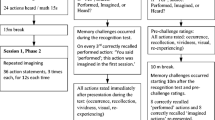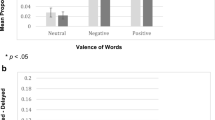Abstract
A social-cognitive model of transference --defined as the activation and application of a mentalrepresentation of a significant other to a new person --has been verified experimentally in terms of relevant inferences and memory about the new person(e.g., Andersen & Cole, 1990; Andersen, Glassman,Chen, & Cole, 1995). The model suggests thattransference should persist and increase over time,indicating that the phenomenon is not fleeting orself-correcting, and is therefore of clinicalimportance. In two within-subject experiments,participants learned about four fictional people, one ofwhom resembled their own significant other. Theythen completeda recognition-memory test. In Study 1, the test wasadministered both immediately after learning about thenew people, and again 2 to 3 weeks afterward . As predicted, greater confidence in havinglearned representation-consistent attributes that hadnot been presented in the learning task occurred in thesignificant-other condition relative to the control conditions -- both immediately and after thedelay, with the effect increasing over time. Thepotential artifact of the first memory test vis-a-visthe second was ruled out in Study 2, which showed thepersistence effect using a test administered only once , 2to 3 weeks after the learning task. Persistence andexacerbation in the effect have theoretical and clinicalimplications, as does the general notion that transference occurs in everyday socialperception on the basis of significant-otherrepresentations.
Similar content being viewed by others
REFERENCES
Allport, G. (1937). Personality: A psychological interpretation. New York: Holt, Rinehart & Winston.
Andersen, S. M., & Baum, A. (1994). Transference in interpersonal relations: Inferences and affect based on significant-other representations. Journal of Personality, 62, 4, 460–497.
Andersen, S. M., & Berk, M. S. (1998). Transference in everyday experience: Implications of experimental research for relevant clinical phenomena. Review of General Psychology, 2, 81–120.
Andersen, S. M., & Cole, S. W. (1990). ''Do I know you? '': The role of significant others in general social perception. Journal of Personality and Social Psychology, 59, 384–399.
Andersen, S. M., & Glassman, N. S. (1996). Responding to significant others when they are not there: Effects on interpersonal inference, motivation, and affect. In R. M. Sorrentino & E. T. Higgins (Eds.), Handbook of motivation and cognition (Vol. 3, pp. 262–321). New York: Guilford Press.
Andersen, S. M., Glassman, N. S., Chen, S., & Cole, S. W. (1995). Transference in social perception: The role of chronic accessibility in significant-other representations. Journal of Personality and Social Psychology, 69, 41–57.
Andersen, S. M., Reznik, I., & Manze lla, L. M. (1996). Eliciting facial affect, motivation, and expectancies in transference: Significant-other representations in social relations. Journal of Personality and Social Psychology, 71, 1108–1129.
Bargh, J. A., Bond, R. N., Lombardi, W. L., & Tota, M. E. (1986). The additive nature of chronic and temporary sources of construct accessibility. Journal of Personality and Social Psychology, 50, 869–878.
Bargh, J. A., Lombardi, W. J., & Higgins, E. T. (1988). Automaticity of chronically accessible constructs in person × situation effects on person perception: It's just a matter of time. Journal of Personality and Social Psychology, 55, 599–605.
Bargh, J. A., & Pratto, F. (1986). Individual construct accessibility and perceptual selection. Journal of Experimental Social Psychology, 22, 293–311.
Beck, A. T. (1983). Cognitive therapy of depression: New perspectives. In P. J. Clayton & J. E. Barrett (Eds.), Treatment of depression: Old controversies and new approaches. New York: Raven Press.
Blatt, S., & Zuroff, D. (1992). Interpersonal relatedness and se lf-definition: Two prototypes for depression. Clinical Psychology Review, 12, 527–562.
Blum, H. (1971). On the conception and development of the transference neurosis. Journal of the American Psychoanalytic Association, 19, 41–53.
Bowlby, J. (1969). Attachment and loss: Vol. 1. Attachment. New York: Basic Books.
Brooks, L. R. (1987). Decentralized control of categorization: The role of prior processing episodes. In U. Neisser (Ed.), Categories reconsidered: The ecological and intellectual bases of categories (pp. 141–174). Cambridge, England: Cambridge University Press.
Bruner, J. S. (1957). Going beyond the information given. In H. E. Gruber, K. R. Hammond, & R. Jessor, Contemporary approaches to cognition (pp. 41–60). Cambridge, MA: Harvard University Press.
Cantor, N., & Mische l, W. (1977). Traits as prototypes: Effects on recognition memory. Journal of Personality and Social Psychology, 35, 38–48.
Collins, A. M., & Loftus, E. (1975). A spreading-activation theory of semantic processing. Psychological Review, 82, 407–428.
Ehrenreich, J. H. (1989). Transference: One concept or many? The Psychoanalytic Review, 76, 1989.
Fairbairn, W. R. D. (1954). Psychoanalytic studies of personality. London, England: Tavistock.
Ferenczi, S. (1990). Introjection and transference. In A. H. Esman (Ed.), Essential papers on transference (pp. 15–27). New York: New York University Press. (Reprinted from Sex in psychoanalysis, pp. 35–57, by S. Ferenczi, 1909, New York: Basic Books.)
Freud, S. (1958). The dynamics of transference. In J. Strachey (Ed. and Trans.), The standard edition of the complete psychological works of Sigmund Freud (Vol. 12, pp. 99–108). London, England: Hogarth. (Original work published 1912.)
Freud, S. (1963). Further recommendations in the technique of psychoanalysis: Recollection, repetition, working through. Therapy and technique (pp. 105–115). New York: Macmillan. (Original work published 1914.)
Gill, M. M., & Hoffman, I. Z. (1982). Analysis of transference (Vol. 2): Studies on nine audio-recorded psychoanalytic sessions. New York: International Universities.
Gilovich, T. (1981). Seeing the past in the present: The effect of associations to familiar events on judgments and decisions. Journal of Personality and Social Psychology, 40, 797–808.
Goldfried, M. R. (1985). In-vivo intervention or transference? In W. Dryden (Ed.), Therapists' dilemmas (pp. 63–74). London, England: Harper & Row.
Gotlib, I., & Hammen, C. (1992). Psychological aspects of depression: Toward a cognitive-interpersonal integration. Chichester, England: Wiley.
Greenberg, J. R., & Mitchell, S. A. (1983). Object relations in psychoanalytic theory. Cambridge, MA: Harvard University Press.
Greenson, R. R. (1965). The working alliance and the transference neurosis. Psychoanalytic Quarterly, 34, 155–181.
Greenwald, A. G., & Banaji, M. R. (1989). The self as a memory system: Powerful, but ordinary. Journal of Personality and Social Psychology, 57, 41–54.
Hammen, C. L. (1992). Cognitive, life stress, and interpersonal approaches to a developmental psychopathology model of depression. Development and Psychopathology, 4, 189–206.
Hammen, C. L., Burge, D., Daley, S. E., Davila, J., Paley, B., & Rudolph, K. D. (1995). Interpersonal attachment cognitions and prediction of symptomatic responses to interpersonal stress. Journal of Abnormal Psychology, 104, 436–443.
Higgins, E. T. (1989). Knowledge accessibility and activation: Subjectivity and suffering from unconscious sources. In J. S. Uleman & J. A. Bargh (Eds.), Unintended thought (pp. 75–123). New York: Guilford Press.
Higgins, E. T. (1996). Knowledge activation: Accessibility, applicability, and salience. In E. T. Higgins & A. W. Kruglanski (Eds.), Social psychology: Handbook of basic principles.
Higgins, E. T., Bargh, J. A., & Lombardi, W. (1985). The nature of priming effects on categorization. Journal of Experimental Psychology: Learning, Memory, and Cognition, 11, 59–69.
Higgins, E. T., & King, G. A. (1981). Accessibility of social constructs: Information processing consequences of individual and contextual variability. In N. Cantor & J. F. Kihlstrom (Eds.), Personality, cognition and social interaction (pp. 69–121). Mahwah, NJ: Erlbaum.
Higgins, E. T., King, G. A., & Mavin, G. H. (1982). Individual construct accessibility and subjective impressions and recall. Journal of Personality and Social Psychology, 43, 35–47.
Higgins, E. T., Rholes, W. S., & Jones, C. R. (1977). Category accessibility and impression formation. Journal of Experimental Social Psychology, 13, 141–154.
Hinkley, K., & Andersen, S. M. (1996). The working self-concept in transference: Significant-other activation and self change. Journal of Personality and Social Psychology, 71, 1279–1295.
Horney, K. (1939). New ways in psychoanalysis. New York: Norton.
Horowitz, M. J. (Ed.). (1991). Person schemas and maladaptive interpersonal patterns. Chicago: The University of Chicago Press.
Horowitz, M. J., Merluzzi, T. V., Ewert, M., Ghannam, J. H., Hartley, D., & Stinson, C. H. (1991). Role-relationship models configuration (RRMC). In M. J. Horowitz (Ed.), Person schemas and maladaptive interpersonal patterns (pp. 115–154). Chicago: University of Chicago.
Johnson, M. K., Hastroudi, S., & Lindsay, D. S. (1993). Source monitoring. Psychological Bulletin, 88, 67–85.
Johnson, M. K., & Raye, C. L. (1981). Reality monitoring. Psychological Review, 88, 67–85.
Kelly, G. A. (1955). The psychology of personal constru cts. New York: Norton.
Kruglanski, A. W. (1989). Lay epistemics and human knowledge: Cognitive and motivational bases. New York: Plenum Press.
Loewald, H. W. (1971). The transference neurosis: Comments on the concept and the phenomenon. Journal of the American Psychoanalytic Association, 19, 54–66.
Luborsky, L. & Crits-Christoph, P. (1990). Understanding transference: The CCRT method. New York: Basic Books.
Mullahy, P. (1970). Psychoanalysis and interpersonal psychiatry. The contributions of Harry Stack Sullivan. New York: Science House.
Murray, S. L, & Holmes, J. G. (1993). Seeing virtues in faults: Negativity and the transformation of interpersonal narratives in close relationships. Journal of Personality and Social Psychology, 65, 707–722.
Murray, S. L., & Holmes J. G. (1994). Storytelling in close relationships: The construction of confidence. Personality and Social Psychology Bulletin, 20, 650–663.
Ogilvie, D. M., & Ashmore, R. D. (1991). Self-with-other representation as a unit of analysis in se lf-concept research. In R. C. Curtis (Ed.), The relational self: Theoretical convergences in psychoanalysis and social psychology (pp. 282–314). New York: Guilford Press.
Persons, J. B. (1989). Cognitive therapy in practice: A case formulation approach. New York: Norton.
Rosenthal, R., & Rosnow, R. L. (1985). Contrast analysis: Focused comparisons in the analysis of variance. New York: Cambridge University Press.
Safran, J. D. (1990). Towards a refinement of cognitive therapy in light of interpersonal theory: I. Theory. Clinical Psychology Review, 10, 87–106.
Safran, J. D., & Gre enberg, L. S. (1986). Hot cognition and psychotherapy process: An information processing/ecological perspective. In P. C. Kendall (Ed.), Advances in cognitive-behavioral research and therapy (Vol. 5). New York: Academic Press.
Safran, J. D., & Muran, J. C. (1996). The resolution of ruptures in the therapeutic alliance. Journal of Consulting and Clinical Psychology, 64, 447–458.
Safran, J. D., & Segal, Z. V. (1990). Interpersonal processes in cognitive therapy. New York: Basic Books.
Schimek, J. (1983). The construction of transference: The relativity of the ''here and now'' and the ''there and then.'' Psychoanalysis and Contemporary Thought, 6, 435–456.
Sedikides, C., & Skowronski, J. J. (1991). The law of cognitive structure activation. Psychology Inquiry, 2, 169–184.
Segal, Z. V., Adams, K. E., & Shaw, B. F. (1992). Do discrepancies in interpersonal perception predict re lapse? A comparison of remitted depressed patients and collaterals. Cognitive Therapy and Research, 16, 437–450.
Segal, Z. V., & Dobson, K. S. (1992). Cognitive models of depression: Report from a consensus development conference. Psychological Inquiry, 3, 219–224.
Singer, J. L. (1985). Transference and the human condition: A cognitive-affective perspective. Psychoanalytic Psychology, 2, 189–219.
Smith, E. R. (1990). Content and process specificity in the effects of prior experiences. In T. K. Srull & R. S. Wyer, Jr. (Eds.), Advances in social cognition (Vol. 3, pp. 1–59). Hillsdale, NJ: Erlbaum.
Smith, E. R., & Zarate, M. A. (1992). Exemplar-based model of social judgment. Psychological Review, 99, 3–21.
Srull, T. K., & Wyer, R. S., Jr. (1979). The role of category accessibility in the interpretation of information about persons: Some determinants and implications. Journal of Personality and Social Psychology, 37, 1660–1672.
Sullivan, H. S. (1940). Conceptions of modern psychiatry. New York: Norton.
Sullivan, H. S. (1953). The interpersonal theory of psychiatry. New York: Norton.
Wachtel, P. L. (1981). Transference, schema, and assimilation: The relevance of Piaget to the psychoanalytic theory of transference. The Annual of Psychoanalysis, 8, 59–76.
Weinshel, E. M. (1971). The transference neurosis: A survey of the literature. Journal of the American Psychoanalytic Association, 19, 67–88.
Westen, D. (1988). Transference and information processing. Clinical Psychology Review, 8, 59–76.
Young, J. E. (1990). Cognitive therapy for personality disorders: A schema-focused approach. Sarasota, FL: Professional Resource Exchange.
Rights and permissions
About this article
Cite this article
Glassman, N.S., Andersen, S.M. Transference in Social Cognition: Persistence and Exacerbation of Significant-Other-Based Inferences over Time. Cognitive Therapy and Research 23, 75–91 (1999). https://doi.org/10.1023/A:1018762724798
Issue Date:
DOI: https://doi.org/10.1023/A:1018762724798




